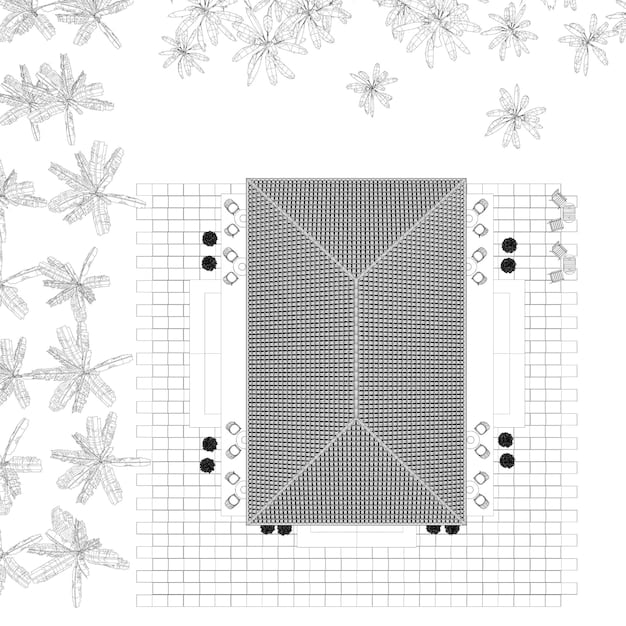Zen Gardening for Beginners: Create a Tranquil Space in 2025

Zen gardening for beginners in 2025 involves creating a peaceful outdoor space using carefully selected elements like rocks, gravel, and plants to promote relaxation and meditation, following simple design principles.
Embark on a journey of tranquility and learn Zen gardening for beginners in 2025, designed to help you construct your own serene space, fostering mindfulness and peace right in your backyard.
Understanding the Essence of Zen Gardening
Zen gardening, also known as Japanese rock gardens, is more than just arranging plants and stones. It’s about creating a miniature landscape that invites contemplation and tranquility. Let’s explore the foundational principles.
The Philosophy Behind Zen Gardens
Zen gardens are deeply rooted in Zen Buddhism, emphasizing simplicity, minimalism, and harmony. These gardens are designed to be viewed from a single vantage point, encouraging meditation and inner peace.
Key Elements of a Zen Garden
The essential components include rocks, gravel, sand, and occasionally, carefully chosen plants like moss or ferns. Each element has a symbolic meaning, contributing to the overall sense of balance and serenity.
- Rocks: Represent mountains or islands, providing structure to the garden.
- Gravel/Sand: Symbolize water, often raked into patterns to mimic waves.
- Plants: Add a touch of life and color, but are used sparingly to maintain simplicity.
- Empty Space: Just as important as the elements themselves, representing the void and inviting contemplation.
Creating a Zen garden requires careful consideration of these elements and their arrangement. The goal is to evoke a sense of calm and balance, inviting you to step away from the stresses of daily life.
Ultimately, understanding the philosophy and key elements is crucial for creating an authentic Zen garden that resonates with your personal sense of peace and tranquility.
Planning Your Zen Garden: Space and Design
Before you begin building your Zen garden, thoughtful planning is essential. Consider the available space and develop a design that aligns with your vision. Here’s how to approach the planning stages.

Assessing Your Space
Evaluate the size and shape of the area you have available. Consider factors like sunlight, drainage, and existing landscaping. A smaller space can be just as effective as a large one, provided it is well-designed.
Developing a Design
Sketch out several design ideas on paper. Experiment with different arrangements of rocks, gravel patterns, and plant placements. Use a grid to help maintain proportions and ensure balance.
- Balance and Symmetry: Aim for a harmonious arrangement where no single element overpowers the others.
- Focal Points: Choose a central rock or plant to draw the eye and create a sense of depth.
- Scale and Proportion: Ensure that the sizes of your elements are appropriately scaled to the size of your garden.
Consider the principles of Japanese garden design, such as asymmetry and the use of negative space. These concepts can help you create a more dynamic and visually appealing garden.
With careful planning and a thoughtful design, your Zen garden can become a true reflection of your personal aesthetic and a source of endless tranquility.
Gathering Your Materials: Rocks, Gravel, and Plants
Selecting the right materials is crucial for creating an authentic and visually appealing Zen garden. From rocks to gravel to plants, each element plays a significant role. Here’s how to choose wisely.
Selecting Rocks and Stones
Choose rocks that vary in size and shape, but complement each other in color and texture. Natural, weathered stones are ideal, as they convey a sense of age and history.
Choosing Gravel and Sand
Gravel and sand are used to represent water in a Zen garden. Opt for fine, light-colored gravel that is easy to rake into patterns. White or light grey sand is also a popular choice.

Incorporating Plants
Plants should be used sparingly to maintain the minimalist aesthetic. Moss, ferns, and carefully pruned bonsai trees are popular choices. Select plants that are low-maintenance and well-suited to your local climate.
- Moss: Adds a soft, green texture and evokes a sense of tranquility.
- Ferns: Provide subtle greenery and complement the natural look of the rocks.
- Bonsai Trees: Offer a touch of elegance and can be carefully shaped to enhance the garden’s aesthetic.
When selecting your materials, consider the overall aesthetic you are trying to achieve. Choose elements that work together harmoniously to create a sense of balance and serenity.
By carefully selecting your rocks, gravel, and plants, you can create a Zen garden that is both visually stunning and deeply calming.
Step-by-Step Guide to Building Your Zen Garden
Now that you have your materials and a design in place, it’s time to start building your Zen garden. Follow these steps for a smooth and successful construction process.
Preparing the Site
Begin by clearing the area of any existing vegetation, rocks, or debris. Level the ground with a rake and tamp it down firmly to create a stable base.
Laying the Foundation
Install a border around the perimeter of your garden using stones, wood, or other materials. This will help contain the gravel and sand and give your garden a clean, finished look.
Arranging the Rocks
Place your rocks according to your design, burying them slightly to give them a sense of permanence. Experiment with different arrangements until you find a composition that feels balanced and harmonious.
Consider the perspective from which your garden will be viewed. The arrangement should be pleasing from your primary vantage point, creating a sense of depth and intrigue.
Adding Gravel and Sand
Carefully pour the gravel or sand into the garden, spreading it evenly with a rake. Use a smoothing tool to create a uniform surface.
- Raking Patterns: Practice raking different patterns into the gravel or sand to mimic the flow of water.
- Wave Patterns: Create gentle, curving lines to suggest ripples and currents.
- Circular Patterns: Form swirling patterns around the rocks to emphasize their presence.
Remember that the patterns are not meant to be permanent. Change them as often as you like to keep your garden fresh and engaging.
By following these steps, you can create a Zen garden that is both beautiful and deeply meaningful, providing a sanctuary for contemplation and relaxation.
Maintaining Your Zen Garden: Raking, Pruning, and Cleaning
Once your Zen garden is complete, regular maintenance is essential to keep it looking its best. Here are some tips for raking, pruning, and cleaning your garden.
Raking Techniques
Raking the gravel or sand is a meditative practice in itself. Use a bamboo rake to create patterns that reflect the movement of water. Experiment with different techniques to find what works best for you.
Pruning Plants
Trim your plants regularly to maintain their shape and prevent them from overgrowing. Remove any dead or yellowing leaves to keep your garden looking healthy and vibrant.
- Bonsai Trees: Prune your bonsai trees according to the specific needs of the species.
- Moss: Keep moss moist and remove any debris that may accumulate on its surface.
- Ferns: Trim back any damaged or overgrown fronds.
Cleaning and Weeding
Remove any fallen leaves, twigs, or other debris that may land in your garden. Hand-pull any weeds that sprout up to prevent them from spreading.
Consider using a leaf blower to gently remove loose debris without disturbing the gravel or sand patterns. Be careful not to displace any of your rocks.
Regular maintenance will ensure that your Zen garden remains a serene and inviting space for years to come.
Enhancing Your Zen Garden: Features and Accessories
To further enhance your Zen garden, consider adding features and accessories that complement its minimalist aesthetic. Here are some ideas to inspire you.
Water Features
A small water feature, such as a bamboo fountain or a stone basin, can add a soothing element to your garden. The sound of trickling water is incredibly calming and can enhance the meditative atmosphere.
Stone Lanterns
Stone lanterns, known as tōrō in Japanese, are traditional elements in Zen gardens. They provide soft, ambient lighting and add a touch of elegance to the space.
- Placement: Position your lantern strategically to highlight focal points or create a sense of depth.
- Style: Choose a lantern that complements the overall aesthetic of your garden.
- Lighting: Consider using solar-powered lanterns for an eco-friendly option.
Meditation Benches
A simple meditation bench or cushion can encourage you to spend more time in your garden, practicing mindfulness and reflection. Choose a comfortable and unobtrusive design that blends seamlessly with the surroundings.
The key to enhancing your Zen garden is to add features that are both functional and aesthetically pleasing, creating a space that invites contemplation and inner peace.
| Key Point | Brief Description |
|---|---|
| 🌱 Garden Planning | Assess space & develop design with balace & focal points. |
| 🪨 Material Selection | Choose natural rocks, light gravel, and minimal plants for simplicity. |
| 🛠️ Building Process | Prepare site, arrange rocks, and add gravel, creating wave patterns. |
| 🌿 Regular Maintenance | Rake patterns, prune plants and clean debris for healthy garden. |
FAQ
▼
The main goal is to create a peaceful space for meditation and contemplation, promoting relaxation and mental clarity by using minimalist elements.
▼
Rake your garden as often as you feel necessary. Daily raking can be a meditative practice, but even weekly maintenance will keep it tidy.
▼
Moss, grass and ferns are great choices becaus they are low-maintenance and drought-tolerant, ideal for easy upkeep while still enhancing the garden visually.
▼
Yes, but do so sparingly. Use plants with subtle greens or subdued blooms and try to incorporate rocks with earthy tones to add color delicately.
▼
Use a weed barrier under your gravel or sand. Regularly hand-pull any weeds that appear to keep them from spreading, maintaining a clean garden.
Conclusion
Creating a Zen Garden for beginners in 2025 is an enriching experience that brings peace and tranquility to your doorstep. By following these steps and understanding the underlying principles, you can transform your outdoor space into a haven of serenity.





